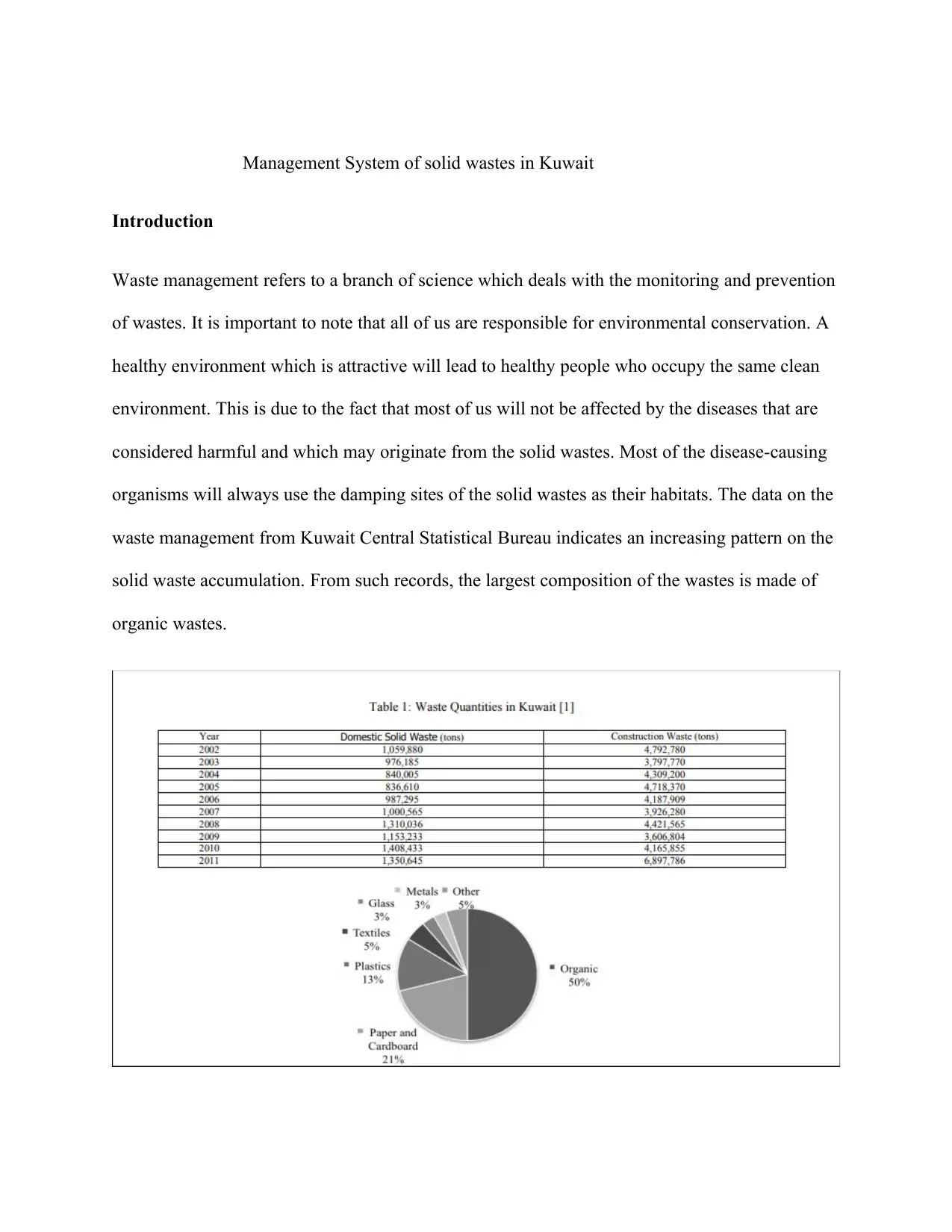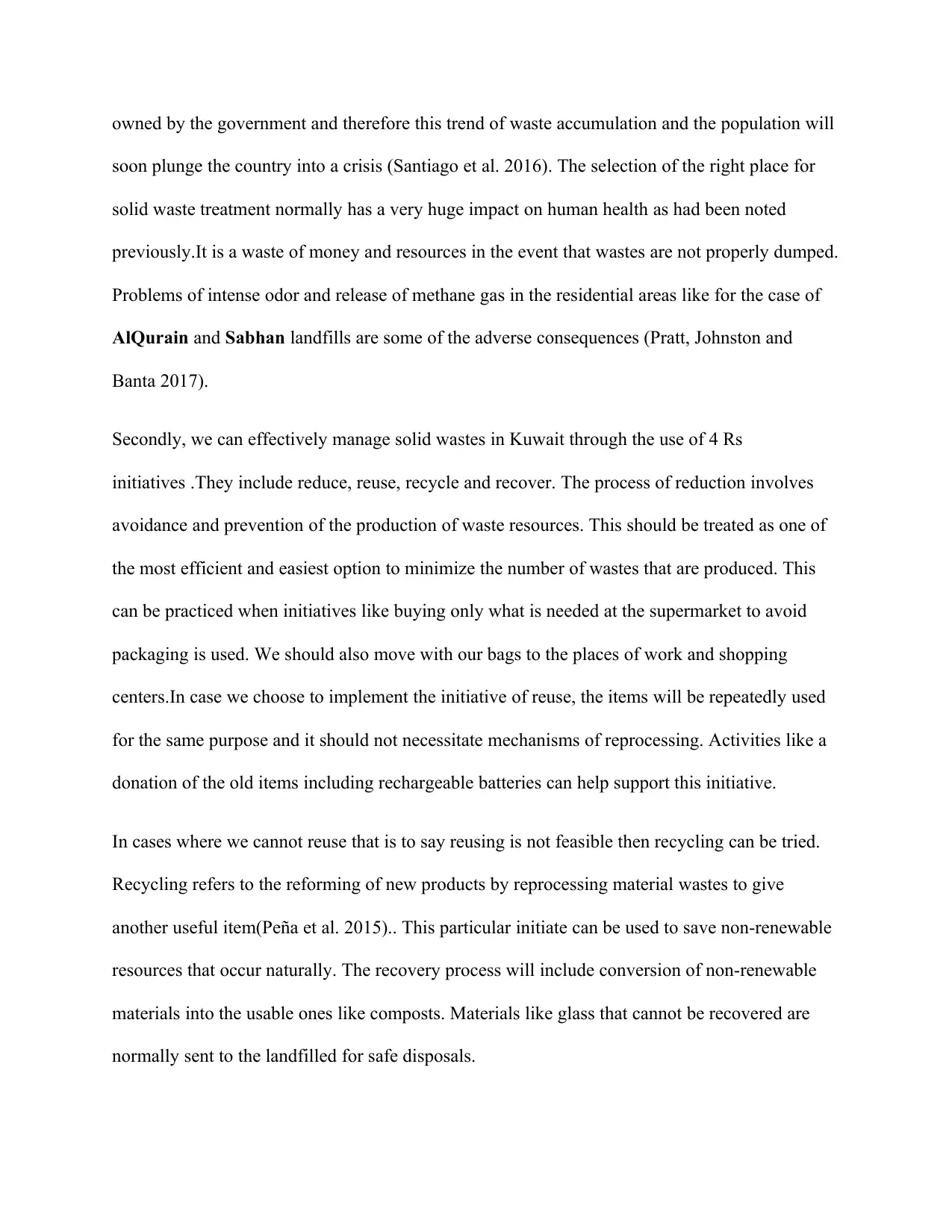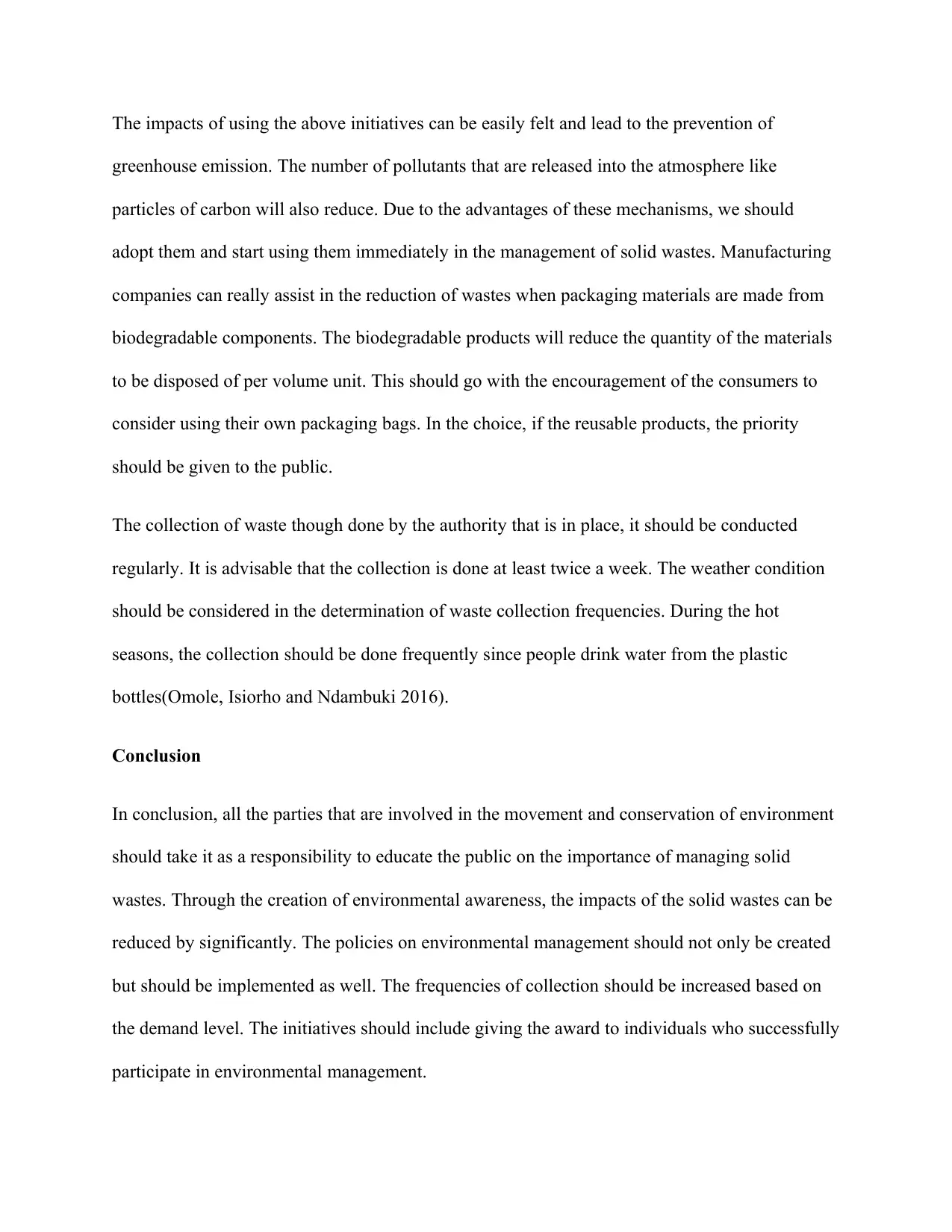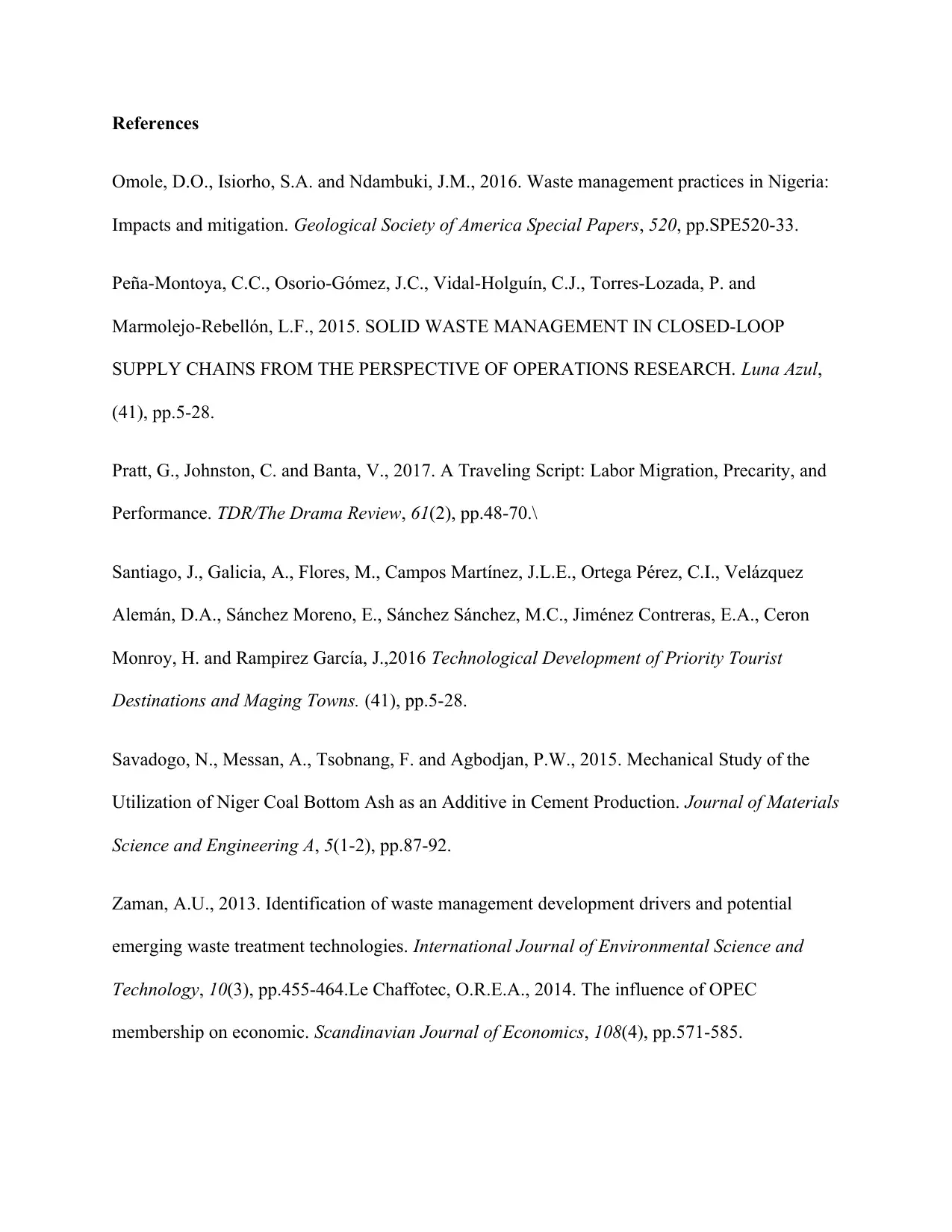Evaluating Solid Waste Management Strategies in Kuwait: A Report
VerifiedAdded on 2023/04/12
|6
|1253
|424
Report
AI Summary
This report provides an overview of the solid waste management system in Kuwait, highlighting the increasing accumulation of solid waste and its composition, with organic wastes forming the largest portion. It discusses current waste management practices, including collection, transportation, recycling, and disposal in landfills, noting the limited capacity of recycling companies and the substandard conditions of existing landfills. The report emphasizes the environmental and health impacts of improper waste disposal, such as odor and methane gas emissions. It proposes the implementation of the 4Rs initiative—reduce, reuse, recycle, and recover—to minimize waste generation and promote sustainable practices. The report concludes by advocating for public education, policy implementation, and increased waste collection frequency to improve solid waste management in Kuwait, suggesting awards for successful environmental management participation.

ADVANCED WASTEWATER
By Name
Course
Instructor
Institution
Location
Date
By Name
Course
Instructor
Institution
Location
Date
Paraphrase This Document
Need a fresh take? Get an instant paraphrase of this document with our AI Paraphraser

Management System of solid wastes in Kuwait
Introduction
Waste management refers to a branch of science which deals with the monitoring and prevention
of wastes. It is important to note that all of us are responsible for environmental conservation. A
healthy environment which is attractive will lead to healthy people who occupy the same clean
environment. This is due to the fact that most of us will not be affected by the diseases that are
considered harmful and which may originate from the solid wastes. Most of the disease-causing
organisms will always use the damping sites of the solid wastes as their habitats. The data on the
waste management from Kuwait Central Statistical Bureau indicates an increasing pattern on the
solid waste accumulation. From such records, the largest composition of the wastes is made of
organic wastes.
Introduction
Waste management refers to a branch of science which deals with the monitoring and prevention
of wastes. It is important to note that all of us are responsible for environmental conservation. A
healthy environment which is attractive will lead to healthy people who occupy the same clean
environment. This is due to the fact that most of us will not be affected by the diseases that are
considered harmful and which may originate from the solid wastes. Most of the disease-causing
organisms will always use the damping sites of the solid wastes as their habitats. The data on the
waste management from Kuwait Central Statistical Bureau indicates an increasing pattern on the
solid waste accumulation. From such records, the largest composition of the wastes is made of
organic wastes.

Figure 1: Composition of waste in Kuwait(Zaman 2013)
Actually, they constitute over 50% of the total waste. In the second position are paperwork and
plastic with the constitution of 21% and 13 % respectively. There are several mechanisms that
are being put place by non-governmental and governmental instructions in Kuwait to manage
solid wastes. Currently, all the wastes are dumped randomly into the landfills without the
consideration of the environmental precautions and safety from the point of transportation and
collection. This is not considered in the last stage which is the use of landfill. The management is
however procedurally done with the first step being a collection and subsequent transportation of
wastes. This is normally done once or twice a day. Every management of such units is made up
of about 4-5 workers with a truck.
These initiatives are poorly managed by the municipalities since there is no material segregation
prior to their disposals and instead they are disposed of directly. Finally, the collected wastes are
undertaken through recycling or disposal of treatment. Unfortunately, the number of waste
recycling companies in Kuwait is very few. The few available companies also have limited
capacity that cannot cover large areas. The remaining portion undergoes treatment or disposal
depending on the composition. There are over sixteen landfills in Kuwait. Apparently, thirteen of
these landfills have been closed leaving behind only three to be operational. It is however very
unfortunate that none of the landfills meets the required standards and criteria of sanitary. The
wastes are therefore randomly dumped into the holes(Savadogo et al.2015).
The area coverage of the of landfills in Kuwait is around 45.5km2. This area coverage is
expected to increase to about 60km2 by the year 2025. Considering the issue of land shortage in
the country, only 25% of the country will bearable for use by the public. Over 75% of the land is
Actually, they constitute over 50% of the total waste. In the second position are paperwork and
plastic with the constitution of 21% and 13 % respectively. There are several mechanisms that
are being put place by non-governmental and governmental instructions in Kuwait to manage
solid wastes. Currently, all the wastes are dumped randomly into the landfills without the
consideration of the environmental precautions and safety from the point of transportation and
collection. This is not considered in the last stage which is the use of landfill. The management is
however procedurally done with the first step being a collection and subsequent transportation of
wastes. This is normally done once or twice a day. Every management of such units is made up
of about 4-5 workers with a truck.
These initiatives are poorly managed by the municipalities since there is no material segregation
prior to their disposals and instead they are disposed of directly. Finally, the collected wastes are
undertaken through recycling or disposal of treatment. Unfortunately, the number of waste
recycling companies in Kuwait is very few. The few available companies also have limited
capacity that cannot cover large areas. The remaining portion undergoes treatment or disposal
depending on the composition. There are over sixteen landfills in Kuwait. Apparently, thirteen of
these landfills have been closed leaving behind only three to be operational. It is however very
unfortunate that none of the landfills meets the required standards and criteria of sanitary. The
wastes are therefore randomly dumped into the holes(Savadogo et al.2015).
The area coverage of the of landfills in Kuwait is around 45.5km2. This area coverage is
expected to increase to about 60km2 by the year 2025. Considering the issue of land shortage in
the country, only 25% of the country will bearable for use by the public. Over 75% of the land is
⊘ This is a preview!⊘
Do you want full access?
Subscribe today to unlock all pages.

Trusted by 1+ million students worldwide

owned by the government and therefore this trend of waste accumulation and the population will
soon plunge the country into a crisis (Santiago et al. 2016). The selection of the right place for
solid waste treatment normally has a very huge impact on human health as had been noted
previously.It is a waste of money and resources in the event that wastes are not properly dumped.
Problems of intense odor and release of methane gas in the residential areas like for the case of
AlQurain and Sabhan landfills are some of the adverse consequences (Pratt, Johnston and
Banta 2017).
Secondly, we can effectively manage solid wastes in Kuwait through the use of 4 Rs
initiatives .They include reduce, reuse, recycle and recover. The process of reduction involves
avoidance and prevention of the production of waste resources. This should be treated as one of
the most efficient and easiest option to minimize the number of wastes that are produced. This
can be practiced when initiatives like buying only what is needed at the supermarket to avoid
packaging is used. We should also move with our bags to the places of work and shopping
centers.In case we choose to implement the initiative of reuse, the items will be repeatedly used
for the same purpose and it should not necessitate mechanisms of reprocessing. Activities like a
donation of the old items including rechargeable batteries can help support this initiative.
In cases where we cannot reuse that is to say reusing is not feasible then recycling can be tried.
Recycling refers to the reforming of new products by reprocessing material wastes to give
another useful item(Peña et al. 2015).. This particular initiate can be used to save non-renewable
resources that occur naturally. The recovery process will include conversion of non-renewable
materials into the usable ones like composts. Materials like glass that cannot be recovered are
normally sent to the landfilled for safe disposals.
soon plunge the country into a crisis (Santiago et al. 2016). The selection of the right place for
solid waste treatment normally has a very huge impact on human health as had been noted
previously.It is a waste of money and resources in the event that wastes are not properly dumped.
Problems of intense odor and release of methane gas in the residential areas like for the case of
AlQurain and Sabhan landfills are some of the adverse consequences (Pratt, Johnston and
Banta 2017).
Secondly, we can effectively manage solid wastes in Kuwait through the use of 4 Rs
initiatives .They include reduce, reuse, recycle and recover. The process of reduction involves
avoidance and prevention of the production of waste resources. This should be treated as one of
the most efficient and easiest option to minimize the number of wastes that are produced. This
can be practiced when initiatives like buying only what is needed at the supermarket to avoid
packaging is used. We should also move with our bags to the places of work and shopping
centers.In case we choose to implement the initiative of reuse, the items will be repeatedly used
for the same purpose and it should not necessitate mechanisms of reprocessing. Activities like a
donation of the old items including rechargeable batteries can help support this initiative.
In cases where we cannot reuse that is to say reusing is not feasible then recycling can be tried.
Recycling refers to the reforming of new products by reprocessing material wastes to give
another useful item(Peña et al. 2015).. This particular initiate can be used to save non-renewable
resources that occur naturally. The recovery process will include conversion of non-renewable
materials into the usable ones like composts. Materials like glass that cannot be recovered are
normally sent to the landfilled for safe disposals.
Paraphrase This Document
Need a fresh take? Get an instant paraphrase of this document with our AI Paraphraser

The impacts of using the above initiatives can be easily felt and lead to the prevention of
greenhouse emission. The number of pollutants that are released into the atmosphere like
particles of carbon will also reduce. Due to the advantages of these mechanisms, we should
adopt them and start using them immediately in the management of solid wastes. Manufacturing
companies can really assist in the reduction of wastes when packaging materials are made from
biodegradable components. The biodegradable products will reduce the quantity of the materials
to be disposed of per volume unit. This should go with the encouragement of the consumers to
consider using their own packaging bags. In the choice, if the reusable products, the priority
should be given to the public.
The collection of waste though done by the authority that is in place, it should be conducted
regularly. It is advisable that the collection is done at least twice a week. The weather condition
should be considered in the determination of waste collection frequencies. During the hot
seasons, the collection should be done frequently since people drink water from the plastic
bottles(Omole, Isiorho and Ndambuki 2016).
Conclusion
In conclusion, all the parties that are involved in the movement and conservation of environment
should take it as a responsibility to educate the public on the importance of managing solid
wastes. Through the creation of environmental awareness, the impacts of the solid wastes can be
reduced by significantly. The policies on environmental management should not only be created
but should be implemented as well. The frequencies of collection should be increased based on
the demand level. The initiatives should include giving the award to individuals who successfully
participate in environmental management.
greenhouse emission. The number of pollutants that are released into the atmosphere like
particles of carbon will also reduce. Due to the advantages of these mechanisms, we should
adopt them and start using them immediately in the management of solid wastes. Manufacturing
companies can really assist in the reduction of wastes when packaging materials are made from
biodegradable components. The biodegradable products will reduce the quantity of the materials
to be disposed of per volume unit. This should go with the encouragement of the consumers to
consider using their own packaging bags. In the choice, if the reusable products, the priority
should be given to the public.
The collection of waste though done by the authority that is in place, it should be conducted
regularly. It is advisable that the collection is done at least twice a week. The weather condition
should be considered in the determination of waste collection frequencies. During the hot
seasons, the collection should be done frequently since people drink water from the plastic
bottles(Omole, Isiorho and Ndambuki 2016).
Conclusion
In conclusion, all the parties that are involved in the movement and conservation of environment
should take it as a responsibility to educate the public on the importance of managing solid
wastes. Through the creation of environmental awareness, the impacts of the solid wastes can be
reduced by significantly. The policies on environmental management should not only be created
but should be implemented as well. The frequencies of collection should be increased based on
the demand level. The initiatives should include giving the award to individuals who successfully
participate in environmental management.

References
Omole, D.O., Isiorho, S.A. and Ndambuki, J.M., 2016. Waste management practices in Nigeria:
Impacts and mitigation. Geological Society of America Special Papers, 520, pp.SPE520-33.
Peña-Montoya, C.C., Osorio-Gómez, J.C., Vidal-Holguín, C.J., Torres-Lozada, P. and
Marmolejo-Rebellón, L.F., 2015. SOLID WASTE MANAGEMENT IN CLOSED-LOOP
SUPPLY CHAINS FROM THE PERSPECTIVE OF OPERATIONS RESEARCH. Luna Azul,
(41), pp.5-28.
Pratt, G., Johnston, C. and Banta, V., 2017. A Traveling Script: Labor Migration, Precarity, and
Performance. TDR/The Drama Review, 61(2), pp.48-70.\
Santiago, J., Galicia, A., Flores, M., Campos Martínez, J.L.E., Ortega Pérez, C.I., Velázquez
Alemán, D.A., Sánchez Moreno, E., Sánchez Sánchez, M.C., Jiménez Contreras, E.A., Ceron
Monroy, H. and Rampirez García, J.,2016 Technological Development of Priority Tourist
Destinations and Maging Towns. (41), pp.5-28.
Savadogo, N., Messan, A., Tsobnang, F. and Agbodjan, P.W., 2015. Mechanical Study of the
Utilization of Niger Coal Bottom Ash as an Additive in Cement Production. Journal of Materials
Science and Engineering A, 5(1-2), pp.87-92.
Zaman, A.U., 2013. Identification of waste management development drivers and potential
emerging waste treatment technologies. International Journal of Environmental Science and
Technology, 10(3), pp.455-464.Le Chaffotec, O.R.E.A., 2014. The influence of OPEC
membership on economic. Scandinavian Journal of Economics, 108(4), pp.571-585.
Omole, D.O., Isiorho, S.A. and Ndambuki, J.M., 2016. Waste management practices in Nigeria:
Impacts and mitigation. Geological Society of America Special Papers, 520, pp.SPE520-33.
Peña-Montoya, C.C., Osorio-Gómez, J.C., Vidal-Holguín, C.J., Torres-Lozada, P. and
Marmolejo-Rebellón, L.F., 2015. SOLID WASTE MANAGEMENT IN CLOSED-LOOP
SUPPLY CHAINS FROM THE PERSPECTIVE OF OPERATIONS RESEARCH. Luna Azul,
(41), pp.5-28.
Pratt, G., Johnston, C. and Banta, V., 2017. A Traveling Script: Labor Migration, Precarity, and
Performance. TDR/The Drama Review, 61(2), pp.48-70.\
Santiago, J., Galicia, A., Flores, M., Campos Martínez, J.L.E., Ortega Pérez, C.I., Velázquez
Alemán, D.A., Sánchez Moreno, E., Sánchez Sánchez, M.C., Jiménez Contreras, E.A., Ceron
Monroy, H. and Rampirez García, J.,2016 Technological Development of Priority Tourist
Destinations and Maging Towns. (41), pp.5-28.
Savadogo, N., Messan, A., Tsobnang, F. and Agbodjan, P.W., 2015. Mechanical Study of the
Utilization of Niger Coal Bottom Ash as an Additive in Cement Production. Journal of Materials
Science and Engineering A, 5(1-2), pp.87-92.
Zaman, A.U., 2013. Identification of waste management development drivers and potential
emerging waste treatment technologies. International Journal of Environmental Science and
Technology, 10(3), pp.455-464.Le Chaffotec, O.R.E.A., 2014. The influence of OPEC
membership on economic. Scandinavian Journal of Economics, 108(4), pp.571-585.
⊘ This is a preview!⊘
Do you want full access?
Subscribe today to unlock all pages.

Trusted by 1+ million students worldwide
1 out of 6
Related Documents
Your All-in-One AI-Powered Toolkit for Academic Success.
+13062052269
info@desklib.com
Available 24*7 on WhatsApp / Email
![[object Object]](/_next/static/media/star-bottom.7253800d.svg)
Unlock your academic potential
Copyright © 2020–2025 A2Z Services. All Rights Reserved. Developed and managed by ZUCOL.





